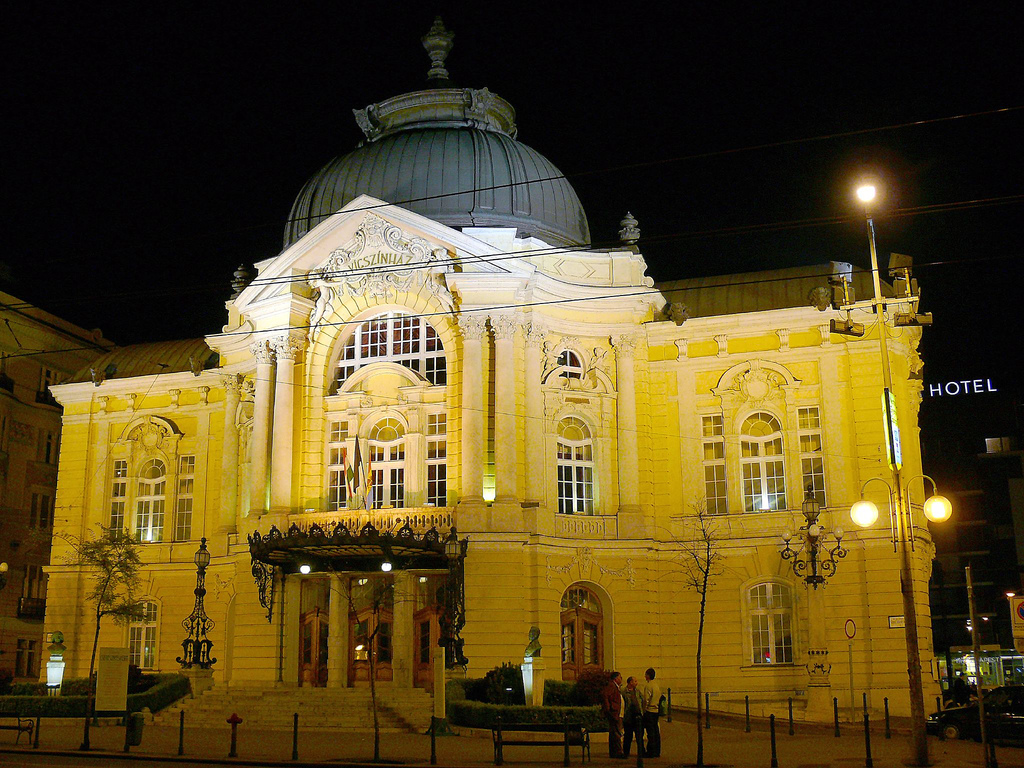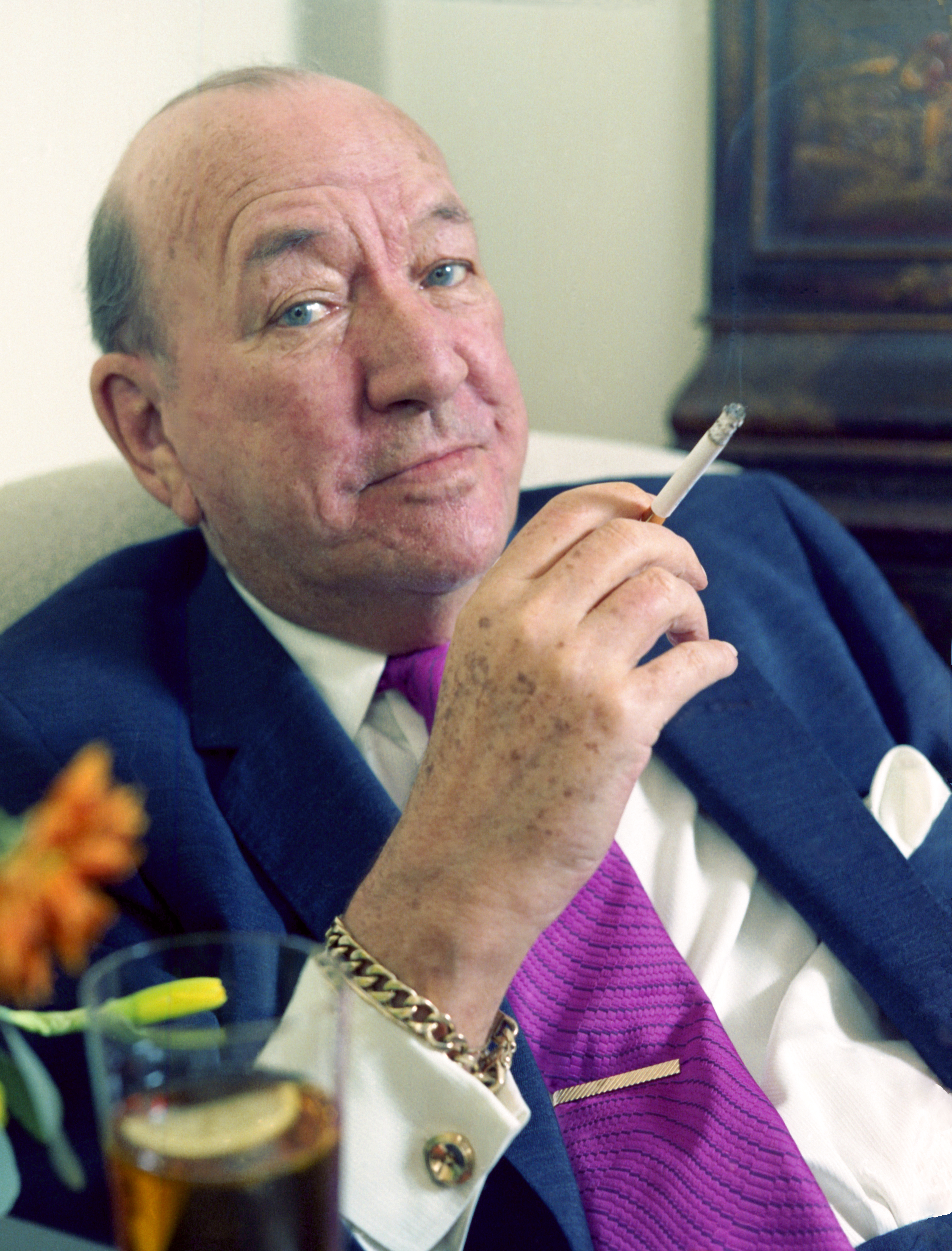|
Teri Náray
Teri Náray (born TerĂ©z Náray; 20 September 1916 - 21 April 1995) was a Hungarian actress. She began a long career on stage at the TerĂ©zkörĂşti Theatre in 1936 and joined the Comedy Theatre of Budapest (VĂgszĂnház) in Budapest 2 years later. From 1951 to 1957 she was an actress at the Youth Theatre, after which she was at the Attila JĂłzsef Theatre until 1972. Among her notable stage roles were Marion in J. B. Priestley's ''The Linden Tree'', Almina Clare in NoĂ«l Coward's '' Waiting in the Wings'' and DonátffynĂ© in Ede Szigligeti Ede Szigligeti (8 March 181419 January 1878) was a Hungarian dramatist. He was born JĂłzsef Szathmáry, at Nagyvárad-Olaszi (presently Oradea, Romania). His parents would have made him a priest; he wanted to be a great doctor; finally he ente ...'s ''Fenn az ernyĹ‘, nincsen kas''. In 1976 she appeared in the TV mini series ''Beszterce ostroma'', and in 1984 she starred in the mini TV series ''KĂĽlönös házasság''. References ... [...More Info...] [...Related Items...] OR: [Wikipedia] [Google] [Baidu] |
Orosháza
Orosháza is a city situated in the westernmost part of Békés county, Hungary, on the Békés ridge bordered by the rivers Maros and Körös. Orosháza is an important cultural, educational and recreational centre of the region. Main sights The city's main attractions are the Orosháza-Gyopárosfürdő spa complex, the Szántó Kovács János Museum, the Darvas József Literary Memorial House, and the Town Art Gallery. The only museum in the country devoted to water wells is found in Orosháza. At the Rágyánszky Arboretum, more than 2000 plant species in 6000 varieties can be seen. The Lutheran church, was built between 1777 and 1830 in late Baroque style. It is located in the centre of the town. The bell carried by the first settlers, who migrated from Zomba, is kept in front of the altar of the church. A number of cultural and entertaining programmes are organised in the town every year. Notable residents * The cantor Marcel Lorand was born in the city in 1912. ... [...More Info...] [...Related Items...] OR: [Wikipedia] [Google] [Baidu] |
Austria-Hungary
Austria-Hungary, often referred to as the Austro-Hungarian Empire,, the Dual Monarchy, or Austria, was a constitutional monarchy and great power in Central Europe between 1867 and 1918. It was formed with the Austro-Hungarian Compromise of 1867 in the aftermath of the Austro-Prussian War and was dissolved shortly after its defeat in the First World War. Austria-Hungary was ruled by the House of Habsburg and constituted the last phase in the constitutional evolution of the Habsburg monarchy. It was a multinational state and one of Europe's major powers at the time. Austria-Hungary was geographically the second-largest country in Europe after the Russian Empire, at and the third-most populous (after Russia and the German Empire). The Empire built up the fourth-largest machine building industry in the world, after the United States, Germany and the United Kingdom. Austria-Hungary also became the world's third-largest manufacturer and exporter of electric home appliances, ... [...More Info...] [...Related Items...] OR: [Wikipedia] [Google] [Baidu] |
Budapest
Budapest (, ; ) is the capital and most populous city of Hungary. It is the ninth-largest city in the European Union by population within city limits and the second-largest city on the Danube river; the city has an estimated population of 1,752,286 over a land area of about . Budapest, which is both a city and county, forms the centre of the Budapest metropolitan area, which has an area of and a population of 3,303,786; it is a primate city, constituting 33% of the population of Hungary. The history of Budapest began when an early Celtic settlement transformed into the Roman town of Aquincum, the capital of Lower Pannonia. The Hungarians arrived in the territory in the late 9th century, but the area was pillaged by the Mongols in 1241–42. Re-established Buda became one of the centres of Renaissance humanist culture by the 15th century. The Battle of Mohács, in 1526, was followed by nearly 150 years of Ottoman rule. After the reconquest of Buda in 1686, the ... [...More Info...] [...Related Items...] OR: [Wikipedia] [Google] [Baidu] |
Hungary
Hungary ( hu, Magyarország ) is a landlocked country in Central Europe. Spanning of the Carpathian Basin, it is bordered by Slovakia to the north, Ukraine to the northeast, Romania to the east and southeast, Serbia to the south, Croatia and Slovenia to the southwest, and Austria to the west. Hungary has a population of nearly 9 million, mostly ethnic Hungarians and a significant Romani minority. Hungarian, the official language, is the world's most widely spoken Uralic language and among the few non-Indo-European languages widely spoken in Europe. Budapest is the country's capital and largest city; other major urban areas include Debrecen, Szeged, Miskolc, Pécs, and Győr. The territory of present-day Hungary has for centuries been a crossroads for various peoples, including Celts, Romans, Germanic tribes, Huns, West Slavs and the Avars. The foundation of the Hungarian state was established in the late 9th century AD with the conquest of the Carpathian Basin by Hungar ... [...More Info...] [...Related Items...] OR: [Wikipedia] [Google] [Baidu] |
Comedy Theatre Of Budapest
The Comedy Theater of Budapest ( hu, VĂgszĂnház) is a theater in Budapest. Starting in the turn of the 19th and 20th century as an opposition to the conservative National Theater, it became a pioneer institution of Hungarian drama, and one of the oldest theaters of the city still in operation. The building The VĂgszĂnház was designed by architects Ferdinand Fellner and Hermann Helmer who worked on over 47 state-of-the-art theater buildings around Europe. Its construction was financed by the tripartite ownership consisting of Count István Keglevich, the writer Ferenc SzĂ©csi, and local businessman Gábor Faludi. I The destined area was a swampland before, but in the next few years it developed into the bourgeois LipĂłtváros district. The construction started in 1895 and lasted for one year, finishing on 1 May 1896. With 3 main tracts: the stage, including the flies; the lower seating tract; and the entry hall; the building exemplifies late historicism, featuring large ... [...More Info...] [...Related Items...] OR: [Wikipedia] [Google] [Baidu] |
Attila JĂłzsef Theatre
Attila (, ; ), frequently called Attila the Hun, was the ruler of the Huns from 434 until his death in March 453. He was also the leader of a tribal empire consisting of Huns, Ostrogoths, Alans, and Bulgars, among others, in Central and Eastern Europe. During his reign, he was one of the most feared enemies of the Western and Eastern Roman Empires. He crossed the Danube twice and plundered the Balkans, but was unable to take Constantinople. His unsuccessful campaign in Persia was followed in 441 by an invasion of the Eastern Roman (Byzantine) Empire, the success of which emboldened Attila to invade the West. He also attempted to conquer Roman Gaul (modern France), crossing the Rhine in 451 and marching as far as Aurelianum (Orléans), before being stopped in the Battle of the Catalaunian Plains. He subsequently invaded Italy, devastating the northern provinces, but was unable to take Rome. He planned for further campaigns against the Romans, but died in 453. After Attila's ... [...More Info...] [...Related Items...] OR: [Wikipedia] [Google] [Baidu] |
The Linden Tree
''The Linden Tree'' is a 1947 play by the English dramatist J. B. Priestley. It was first produced at the Duchess Theatre, London on 15 August 1947, and ran for 422 performances."Duchess Theatre", ''The Times'' 16 August 1947, p. 6''The Linden Tree'' J B Priestley Society. Retrieved 26 November 2017 The play had a brief run on in New York in March 1948 in a production directed by George Schaefer and using costumes designed by . |
Noël Coward
Sir Noël Peirce Coward (16 December 189926 March 1973) was an English playwright, composer, director, actor, and singer, known for his wit, flamboyance, and what ''Time'' magazine called "a sense of personal style, a combination of cheek and chic, pose and poise"."Noel Coward at 70" ''Time'', 26 December 1969, p. 46 Coward attended a dance academy in London as a child, making his professional stage début at the age of eleven. As a teenager he was introduced into the high society in which most of his plays would be set. Coward achieved enduring success as a playwright, publishing more than 50 plays from his teens onwards. Many of his works, such as '' |
Waiting In The Wings (play)
''Waiting in the Wings'' is a play by Noël Coward. Set in a retirement home for actresses, it focuses on a feud between residents Lotta Bainbridge and May Davenport, who once both loved the same man. Background ''Waiting in the Wings'' was Coward's fiftieth play.Simon, John"Waiting in the Wings" ''The NY Magazine'', 3 January 2000 It premiered in Dublin on 8 August 1960 at the Olympia Theatre, and in the West End at the Duke of York's Theatre on 7 September 1960. It was directed by Margaret Webster and starred Sybil Thorndike, Lewis Casson, Marie Lohr and Graham Payn.Morley, Sheridan. Introduction (unnumbered page) to Coward: Plays, Five. Methuen, 1994, Binkie Beaumont, who usually presented Coward's plays in London, turned it down as "old fashioned". Michael Redgrave put together "a starry cast led by... an amazing gathering of old actresses, many of whom had been stars when Noel was just starting out." Coward later wrote that in the pre-London tour to Dublin, Liverpool an ... [...More Info...] [...Related Items...] OR: [Wikipedia] [Google] [Baidu] |
Ede Szigligeti
Ede Szigligeti (8 March 181419 January 1878) was a Hungarian dramatist. He was born József Szathmáry, at Nagyvárad-Olaszi (presently Oradea, Romania). His parents would have made him a priest; he wanted to be a great doctor; finally he entered the office of an engineer. But his heart was already devoted to the drama and, on 15 August 1834, despite the prohibition of his tyrannical father, he actually appeared upon the stage at Budapest. His father thereupon forbade lim to bear his name in future, and the younger Szathmary henceforth adopted instead the name of Ede Szigligeti, the hero of one of Sandor Kisfaludy's romances. He supported himself for the next few years precariously enough, earning as he did little more than twelve florins a month, but at the same time he sedulously devoted himself to the theatre and sketched several plays, which differed so completely from the "original" plays then in vogue ('' The Played-out Trick'' actually appeared upon the boards) that the ... [...More Info...] [...Related Items...] OR: [Wikipedia] [Google] [Baidu] |
1916 Births
Events Below, the events of the First World War have the "WWI" prefix. January * January 1 – The British Empire, British Royal Army Medical Corps carries out the first successful blood transfusion, using blood that had been stored and cooled. * January 9 – WWI: Gallipoli Campaign: The last British troops are evacuated from Gallipoli, as the Ottoman Empire prevails over a joint British and French operation to capture Constantinople. * January 10 – WWI: Erzurum Offensive: Russia defeats the Ottoman Empire. * January 12 – The Gilbert and Ellice Islands Colony, part of the British Empire, is established in present-day Tuvalu and Kiribati. * January 13 – WWI: Battle of Wadi (1916), Battle of Wadi: Ottoman Empire forces defeat the British, during the Mesopotamian campaign in modern-day Iraq. * January 29 – WWI: Paris is bombed by German Empire, German zeppelins. * January 31 – WWI: An attack is planned on Verdun, France. February * ... [...More Info...] [...Related Items...] OR: [Wikipedia] [Google] [Baidu] |




